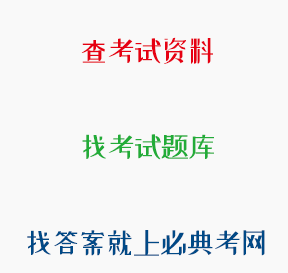正确答案: D
文具--钢笔
题目:下列选项中与"砚台--端砚"逻辑关系一致的是( )。
解析:题干考查包含关系。砚台包含端砚、歙砚、洮河砚等。D项,文具包含钢笔。故选择D项。
查看原题 查看所有试题
学习资料的答案和解析:
[单选题]孔子是我国古代伟大的教育家,他的思想集中体现在他的弟子们编撰的言论记录集里面,该对话集是( )。
《论语》
解析:《论语》较为集中地反映了孔子的思想,是由他的弟子及再传弟子编撰而成。
[单选题]美育的基本任务不包括( )。
培养和发展学生的智力才能,增强学生各方面能力
解析:培养和发展学生的智力才能,增强学生各方面能力是智育的基本任务。
[单选题]我国中小学普遍实行的学科课程及相应的理论,是( )的表现。
课程即知识
解析:传统观点认为,课程即知识。英国社会学家斯宾塞"什么知识最有价值"的思想,已经表达了将课程看作知识的倾向。世界范围内的近代课程体系主要是在这种观点影响下建立的。这种课程观仍然是目前最具代表性和广泛性的。我国中小学普遍实行的学科课程及相应的理论,就是这种观点的表现。
[单选题]教学从本质上讲是一种特殊的认识活动。( )A.正确B.错误
解析:教学是一种特殊的认识、交往和实践活动,这是教学的本质。其特点有教学以培养全面发展的人为根本目的;教学由教与学两方面组成,教学是师生双方的共同活动:学生的认识活动是教学中的重要组成部分;教学具有多种形态,是共性与多样性的统一。教学不同于智育,教学是智育的主要途径之一。
[单选题]启发式教学是一种具体的教学方法。A.正确B.错误
解析:启发式教学,就是根据教学目的、内容、学生的知识水平和知识规律,运用各种教学手段,采用启发诱导办法传授知识、培养能力,使学生积极主动地学习,以促进身心发展。这里要着重说明,启发式教学不仅是教学方法,更是一种教学思想,是教学原则和教学观。
[单选题]改变客观事物形象中的某一部分,突出其特点,从而产生新形象。这种想象的认知加工方式是( )。
夸张
解析:夸张是改变客观事物的正常特征,使事物的某一部分或一种特性增大、缩小、数量增多、色彩加浓等在头脑中形成新形象的过程。
[单选题]李老师对自己的教学能力十分自信,认为自己能教好学生。这主要反映了他的哪种心理特征?
教学效能感
解析:所谓教师的教学效能感,是指教师对自己影响学生学习行为和学习成绩能力的主观判断。题目中李老师对自己的教学能力十分自信,认为自己能教好学生,可见李老师的教学效能感较高。
[单选题]请阅读 Passage 1,完成1~5小题。
Passage 1
In the field of psychology,there has long been a certain haziness surrounding the definition of creativity,an I-know-it-when-I-see-it attitude that has eluded a precise formulation.During our conversation,Mark Beeman,a cognitive neuroscientist at Northwestern University,told me that he used to be reluctant to tell people what his area of study was,for fear of being dismissed or misunderstood.What,for instance,crosses your mind when you think of creativity? Well,we know that someone is creative if he produces new things or has new ideas.And yet,as John Kounios,a psychologist at Drexel University who collaborates frequently with Beeman,points out,that view is wrong,or at least not entirely right."Creativity is the process,not the product," he says.
To illustrate,Beeman offers an example.Imagine someone who has never used or seen a paperclip and is struggling to keep a bunch ofpapers together.Then the person comes up with a new way of bending a stiff wire to hold the papers in place. "That was very creative," Beeman says.On the flip side,if someone works in a new field-Beeman gives the example of nanotechnology-anything that he produces may be considered inherently "creative".But was the act of producing it actually creative? As Beeman put it,"Not all artists are creative.And some accountants are very creative."
Insight,however,has proved less difficult to define and to study.Because it arrives at a specific moment in time,you can isolate it,examine it,and analyze its characteristics."Insight is only one part of creativity," Beeman says."But we can measure it.We have a temporal marker that something just happened in the brain.I'd never say that's all of creativity,but it's a central, identifiable component." When scientists examine insight in the lab.they are looking at what types of attention and thought processes lead to that moment of synthesis: If you are trying to facilitate
a breakthrough,are there methods you can use that help? If you feel stuck on a problem,are there tricks to get you through?
In a recent study,Beeman and Kounios followed people's gazes as they attempted to solve what's called the remote-associates test,in which the subject is given a series of words,like "pine" "crab" and "sauce" and has to think of a single word that can logically be paired with all of them.They wanted to see if the direction of a person's eyes and her rate ofblinking could shed light on her approach and on her likelihood of success.It turned out that if the subject looked directly at a word and focused on it-that is,blinked less frequently,signaling a higher degree of close attention-she was more likely to be thinking in an analytical,convergent fashion,going through possibilities that made sense and systematically discarding those that didn't.If she looked at "pine" say,she might.be thinking of words like "tree" "cone" and "needle" ,then testing each option to see if it fit with the other words.When the subject stopped looking at any specific worD.either by moving her eyes or by blinking,she was more likely to think of broader,more abstract associations.That is a more insight-oriented approach."You need to learn not just to stare but to look outside your focus," Beeman says.(The solution to this remote-associates test: "apple" .)
As it turns out,by simple following someone's eyes and measuring her blinks and fixation times,Beeman's group can predict how someone will likely solve a problem and when she is nearing that solution.That's an important consideration for would-be creative minds: it helps us understand how distinct patterns of attention may contribute to certain kinds ofinsights.
According to john Kounios,what does the underlined word "that" in PARAGRAPH TWO refer to?
The process of making a paperclip.
解析:指代题。根据画线单词that前的句子“To illustrate,Beeman offers an example.Imagine someone who has never used or seen a paperclip and is struggling to keepa bunch of papers together.Then the person comes up with a new way of bending a stiff wire to hold the papers in place.”可知,为了解释其观点,Beeman举了一个例子。试想一个从未使用过或者见过回形针的人正在努力将一堆纸叠在一起。然后他想到将一根金属丝掰弯以固定纸堆的办法。又根据第一段最后一句“Creativityis the process,not the product”可知,that指的是做回形针的过程。故本题选D。

 川公网安备 51012202001360号
川公网安备 51012202001360号